Shocked if not flabbergasted to realize that I had yet to visit three small towns in the northwest corner of Chungcheongbuk Province, I set out to rectify the matter with a mid-summer excursion. Although Tropical Storm Falcon coming up from the Philippines was expected to drench the entire country, that would prove to be but a minor problem.
I got to Geumwang (also known as “Mugeuk”) by 10:30 a.m. The city’s bus terminal, probably constructed in the 1960s, intrigued me. It had character, although some people might call it sad and dreary. I may be wrong, but the first floor appeared to have been a jail in its earliest incarnation. Directly across the street was a large Asia Mart and next door a government office meant to aid immigrants. A stone’s throw away were a couple of restaurants advertising halal food. While I am not sure what 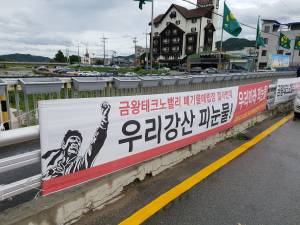 industry(ies) is (are) responsible for drawing so many of these men here, their presence was hard to miss. If it was true of Geumwang, I could say the same about Jincheon and Jeungpyeong, the two cities that followed. Korea, which long bragged about its ethnic purity, is becoming a polyglot nation much like the USA.
industry(ies) is (are) responsible for drawing so many of these men here, their presence was hard to miss. If it was true of Geumwang, I could say the same about Jincheon and Jeungpyeong, the two cities that followed. Korea, which long bragged about its ethnic purity, is becoming a polyglot nation much like the USA.
I read that a gold and silver mine in Geumwang, shuttered more than 30 years ago, had reopened under the auspices of a London-based company. During my three hours in the city, however, I was unable to learn any more about it. Were some of the above-cited non-Korean Asians (and a few Africans) laboring as miners? I can merely speculate.
Espying a pergola set on the side of a mountain not far from downtown, I went and climbed up. This provided a nice view of Geumwang. I walked through the market—as I would do in the other two towns—and saw a protest banner of some kind. I was informed that it was about a planned waste landfill. The citizens did not favor this and said, “Our land is weeping tears of blood!”
I knew I would not be spending the night in Geumwang, so I hopped on a bus for Jincheon about 25 kilometers to the southwest. On the way, we went through Chungbuk Innovation City. This, I must tell you, was a bit weird because I saw hardly a single person on the streets; traffic was very light. The terms “empty,” “dry” and “desolate” seem appropriate to describe this place which the government set aside a decade ago in the name of balanced regional development. While ten public institutions have been enticed/forced to move here, just 16,000 persons call it home. I bet they do not fill up even a quarter of the housing towers I saw. Not all cities grow naturally and organically, I realize, but it seems that some urban planners (aided and abetted by real estate developers with an eye on the main chance) have screwed up. Other Korean “innovation cities” can be found in Naepo, Pyeongchon, Songdo, Ilsan, Bundang and Cheongna. I can only hope that each of them is livelier than what I beheld here.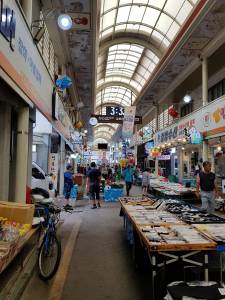
I got to Jincheon, paid 40,000 won for a room in the Sharp (“#”) Motel and went on out. What did I see but another banner, this one pertaining to international politics. It said, “Don’t buy Japanese products!” I will summarize: Korea is still infuriated by the 1910−1945 colonial era and the so-called comfort women issue, and Japan’s perceived lack of remorse. Prime Minister Shinzo Abe is playing hardball in response and threatening to withhold key materials needed to make semiconductors. President Moon Jae-in has dug in his heels as well, and boom—potential trade war! The financial and political repercussions involve not just Tokyo and Seoul, but Washington and Beijing. U.S. National Security Adviser John Bolton was on his way to the region in an attempt to defuse tensions during my trip.
The first of two things I really had to see in Jincheon was the Bell Museum. Bells were first brought to Korea from China. But, as with ceramics, papermaking and movable type printing, the Koreans outdid their teachers. Bells have played an important role in Korean history (some truly huge ones were made during the Silla dynasty), and yet most of us are unaware of their purposes, the varieties of bells, how 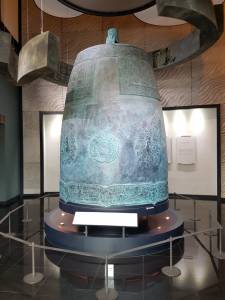 they are crafted, the symbolism and the sounds. This museum, which opened in 2005, was put in Jincheon because of the discovery of a fourth-century iron manufacturing furnace nearby. Never before did I know that the reinforced strike point of a big Buddhist temple bell is called the danghwa. As fascinating as I found this topic, it seems odd that I have never gone to downtown Seoul for the ritualistic ringing of the Bosingak bell to signal the start of a new year. (In fact, there are two reasons—it’s always cold, and the crowd is huge and dense.)
they are crafted, the symbolism and the sounds. This museum, which opened in 2005, was put in Jincheon because of the discovery of a fourth-century iron manufacturing furnace nearby. Never before did I know that the reinforced strike point of a big Buddhist temple bell is called the danghwa. As fascinating as I found this topic, it seems odd that I have never gone to downtown Seoul for the ritualistic ringing of the Bosingak bell to signal the start of a new year. (In fact, there are two reasons—it’s always cold, and the crowd is huge and dense.)
Great as the Jincheon Bell Museum was, what followed was even better. A taxi took me to the site of Nongdari, the oldest bridge in Korea. This place exudes history, with a shrine, a Confucian school and numerous grave markers out front. I stopped at the Nongdari Museum first, got a brochure and walked through it, learning how the bridge was built according to scientific principles more than 1,000 years ago, supposedly by a Goryeo-era general named Lim. There are numerous legends about Nongdari, and it must have witnessed a lot of real-life history. Made of a series of large boulders, it is 94 meters long, an average of 3.6 meters wide and has 28 bays under which the water of the Segeum River flows. Nongdari, classified as a “clapper bridge,” is said to resemble a series of fish scales, and I suppose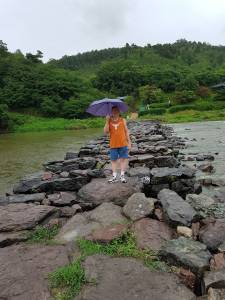 it does. The wisdom of our Korean ancestors can be felt here. While the museum director was quite nice, he misspoke in calling Nongdari the oldest bridge in the world. Not even close, as several are much older; the Tarr Steps in Somerset, England (also a clapper bridge) may have been built in the Bronze Age, and others in Turkey, Greece, Italy and Iran are centuries older.
it does. The wisdom of our Korean ancestors can be felt here. While the museum director was quite nice, he misspoke in calling Nongdari the oldest bridge in the world. Not even close, as several are much older; the Tarr Steps in Somerset, England (also a clapper bridge) may have been built in the Bronze Age, and others in Turkey, Greece, Italy and Iran are centuries older.
I made my way to Nongdari, walking to the other side and back. With the steady rain of Tropical Storm Falcon coming down, I traversed it carefully. There were only a few others out on the bridge, which was fine with me. But this seems like an obvious example of how Korea could better promote tourism. I thought Nongdari was wonderful, stirring and significant. For a millennium, people have been crossing this bridge, and while it is periodically repaired it is still in use! Ancient literature makes several references to it. I have seen more of Korea over the past 12 years than all but a handful of people, and I must say Nongdari makes my top-ten list, easy. Given better weather, I would have stayed much longer.
A bus ride back into town, and I found a restaurant specializing in porridge. I chose one with oysters and mussels, consuming it as I read a biography of John Rosenfield, chief of the Dallas Morning News’ arts department between 1925 and 1966.
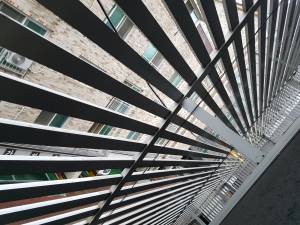 I must say a word about my hotel. It, like several others I have stayed at in Korea, featured metal cladding all around. I find this both perplexing and displeasing. What, I wonder, is the reason? From the outside, I suppose it looks somewhat cool and sexy. From the inside, however, there are problems. For one, I open the window and can barely see what’s across the street. More important is the matter of safety. My room, like all the others, was provided with a “Simple Descending Life Line,” a contraption and rope for making a hasty exit in case fire were to break out. But this thing was rendered completely useless because of the darn cladding.
I must say a word about my hotel. It, like several others I have stayed at in Korea, featured metal cladding all around. I find this both perplexing and displeasing. What, I wonder, is the reason? From the outside, I suppose it looks somewhat cool and sexy. From the inside, however, there are problems. For one, I open the window and can barely see what’s across the street. More important is the matter of safety. My room, like all the others, was provided with a “Simple Descending Life Line,” a contraption and rope for making a hasty exit in case fire were to break out. But this thing was rendered completely useless because of the darn cladding.
I got up the next morning, checked out and rode a bus to Jeungpyeong, 20 kilometers to the southeast. Outside of the bus terminal there, a half-dozen taxi drivers were puffing on cigarettes and waiting for a passenger. “Hey, guys, what’s up?” I said. I showed them photos of where I wanted to go, a rather unusual facility—the Children’s Bicycle Park. The one who took me there must have been smirking the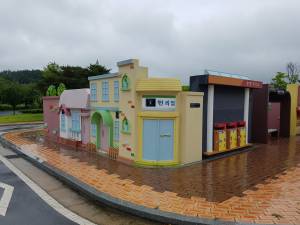 entire time. A far cry from the history and solemnity of Nongdari, I will admit, but I wanted to see it. The park was funny and cute, a miniature village with a post office, a grocery store, a police station, a pharmacy and so on, all painted in vivid colors. On this rainy day, there were no kids on bikes to liven up the scene. No more than 20 minutes later, I was on a bus going back to town. I had a cup of coffee and did some walking. I noted a sign for a temple, a tomb of some long-ago important man and a shrine but quickly demurred. I was tired, a bit wet and ready to be homeward bound. After buying a ticket in the Jeungpyeong bus terminal, I had a brief encounter with a dark-skinned, bright-eyed guy wearing a Sri Lanka T-shirt. Although I dearly wanted to talk to him and learn his story, there was no time. The bus was leaving.
entire time. A far cry from the history and solemnity of Nongdari, I will admit, but I wanted to see it. The park was funny and cute, a miniature village with a post office, a grocery store, a police station, a pharmacy and so on, all painted in vivid colors. On this rainy day, there were no kids on bikes to liven up the scene. No more than 20 minutes later, I was on a bus going back to town. I had a cup of coffee and did some walking. I noted a sign for a temple, a tomb of some long-ago important man and a shrine but quickly demurred. I was tired, a bit wet and ready to be homeward bound. After buying a ticket in the Jeungpyeong bus terminal, I had a brief encounter with a dark-skinned, bright-eyed guy wearing a Sri Lanka T-shirt. Although I dearly wanted to talk to him and learn his story, there was no time. The bus was leaving.

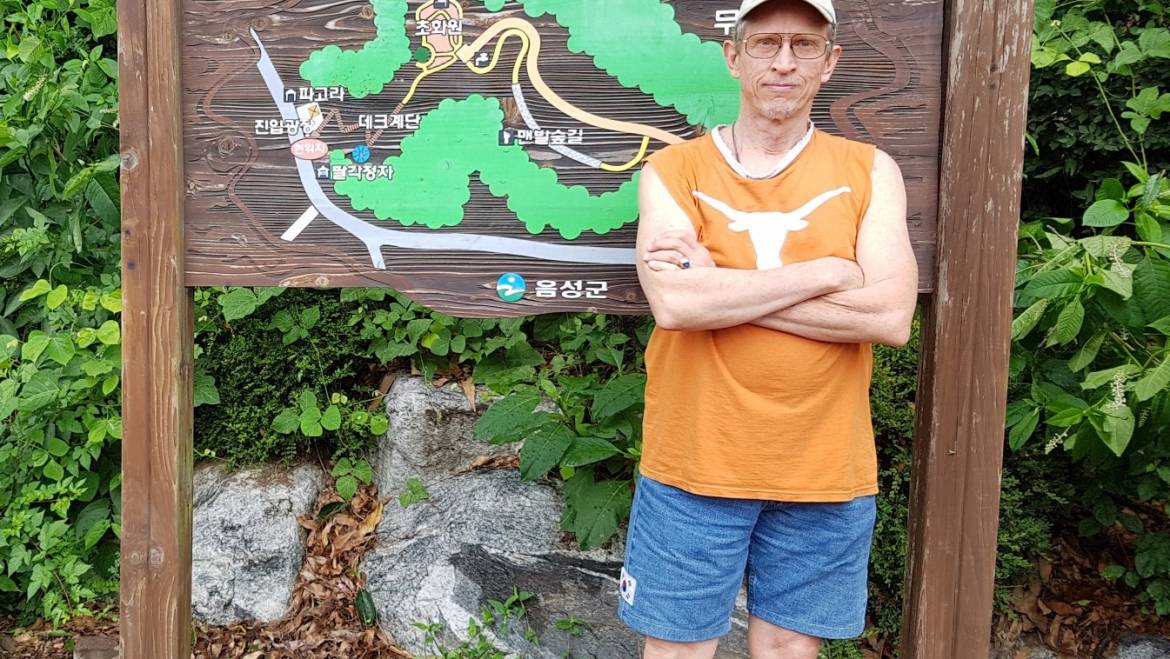
2 Comments
Richard-I found this article very interesting. I had not heard of the Nongdari bridge, the Jincheon Bell Museum, and the other sites you visited. The bridge was beautiful-I was not aware of “clapper bridges”, rather low tech, but beautiful and effective. And I wish we had a children’s Bicycle Park here-the grandkids would love it! Kevin
Kevin, thanks for reading it and for your comment. It’s true that Nongdari is a rather low-tech bridge. That was my first reaction upon seeing it. But 1,000 years it has lasted!!
Add Comment